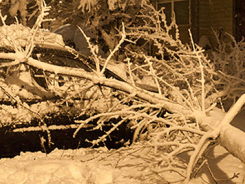Winter Weather
Winter weather and storms can range from mild to severe, and can include dangerously low temperatures, snow, sleet, and hail, along with strong and blinding winds. These storms can affect wide geographic areas, and may contribute to serious health and safety concerns.
Contribute to "a nation of resilient communities" by educating yourself and others on disaster health topics related to winter weather. NCDMPH has gathered resources to assist health professionals in preparing for winter weather. By providing these resources, the National Center aims to foster resilience through learning. The organization of this content is intended to facilitate self-directed learning as well as provide materials for educators. This is an initial effort and we will continue to add to these resources.
Ideas for educators who are teaching health professionals interested in learning content or activities related to health impacts of winter weather emergencies may be found below.
Winter Weather Resources
National Library of Medicine Disaster Information Management Research Center: Weather and Storms
National Weather Service: Winter Windchill Chart
Centers for Disease Control and Prevention (CDC): Winter Weather FAQs
American Academy of Pediatrics: Winter Storm Tips
CDC: Winter Weather Public Service Announcements (PSAs) and Podcasts
CDC: Preparing for and Responding to Extreme Heat and Cold Events
CDC National Institute for Occupational Safety and Health (NIOSH): Cold Stress
American Red Cross: Winter Storm Preparedness
Federal Emergency Management Agency (FEMA): Winter Storms & Extreme Cold
National Oceanic and Atmospheric Administration, US Department of Commerce, National Weather Service, American Red Cross: Winter Storms - The Deceptive Killers
Xu G. et al. Incidences, Types, and Influencing Factors of Snow Disaster-Associated Injuries in Ningbo, China, 2008. Disaster Medicine and Public Health 2012 Dec; 6 (4): 363-9
CDC: Hypothermia
CDC: Frostbite
US Department of Health and Human Services (Flu.gov): Seasonal Flu
Analitis, A., et al. Effects of Cold Weather on Mortality: Results from 15 European Cities Within the PHEWE Project. American Journal of Epidemiology 2008; 168 (12): 1397-1408
Mercer, JB. Cold - An Underrated Risk Factor for Health. Environmental Research 2003; 92 (1): 8-13
Canadian Centre for Occupational Health and Safety: Health Effects of Cold
Nayha, S.: Cold and the risk of cardiovascular diseases. A review. Int J Circumpolar Health 2002 Nov; 61 (4): 373-80
Smirniotopoulos, James. Dangers of Carbon Monoxide: MedPix COW No. 699 (YouTube)
CDC, NIOSH: Cold Stress
Levy, JL, et al: A novel intervention for decreasing hospital crowding following the blizzards of 2010. Am J Disaster Med 2011 Jul-Aug 6; (4): 255-8
Gaynor, PT. Snow: Building a better all-hazards response. J Bus Contin Emer Plan 2013 Summer; 6 (4): 314-21
NCDMPH: Tracking and Reunification of Children in Disasters
Agency for Healthcare Research and Quality: Hospital Evacuation Decision Guide
CDC: Winter Weather Checklists
FEMA: National Shelter System Fact Sheet
American Red Cross: Winter Storm Safety Checklist
FEMA: U.S. Fire Administration:Winter Fire Safety
National Fire Protection Association: Put a Freeze on Winter Fires
US National Library of Medicine & National Institutes of Health: Medline Plus: Coping with Disasters
US National Library of Medicine & National Institutes of Health: Medline Plus: Seasonal Affective Disorder
SAMHSA. Post-Disaster Retraumatization: Risk and Protective Factors.
Learning Objectives & Activities- Winter Weather
Winter Weather Emergencies - Ideas for Educators of Health Professionals
Below are ideas for educators who are teaching health professionals and may wish to develop learning content or activities related to health impacts of winter weather. These ideas should be customized based on the learners, their needs, scope of practice, and the educational context.
Options for Learning Objectives:
At the end of the learning activity, the learner will be able to:
-
Explain how winter weather and storms impact human health, especially in health systems, clinical, and public health dimensions.
-
State ways in which health professionals can contribute to preparedness for, response to, and recovery from winter weather emergencies given their scope of practice.
-
Critically analyze the multiple role-based expectations of health professionals in winter weather emergencies. Major role categories include:
-
individual
-
family (significant others)
-
organization
-
profession
-
community
-
-
Describe strategies for safe sheltering practices during extreme cold and snow events.
Options for Learning Activities:
-
Walk through the resources online during class and discuss their applicability and utility for the learner.
-
Lead a class discussion about the health and systems impacts of winter weather. Possible discussion questions are:
-
Describe the types of illness and injury associated with winter weather and storms.
-
What are the public health implications of winter weather emergencies?
-
What effects might a winter storm have on different health systems, such as hospitals, EMS, and healthcare coalitions?
-
What information should health professionals provide for safe sheltering during an extreme cold or snow event?
-
-
Ask learners to respond to the following question, either verbally or in writing: How can you as a health professional, within your scope of practice, contribute to the preparedness for, response to, and recovery from a winter weather emergency?
-
In the context of a winter weather disaster, consider the following:
-
What do you expect of yourself?
-
What does your family (significant others) expect of you?
-
What does your organization expect of you?
-
What does your profession expect of you?
-
What does the community expect of you?
-
-
Invite learners to work in small groups to draft a public service announcement for your county on actions citizens should take to reduce injury and death from winter weather emergencies.
-
Invite a member of another response professional group to discuss interprofessional coordination and collaboration necessary in response to a winter storm. Discuss barriers to such interprofessional coordination and collaboration.
-
As a group, identify a population that is particularly vulnerable to adverse health effects during a winter weather emergency. Develop strategies that could be implemented to protect their well-being during these events. What professions or organizations in your local community could participate in this effort?
